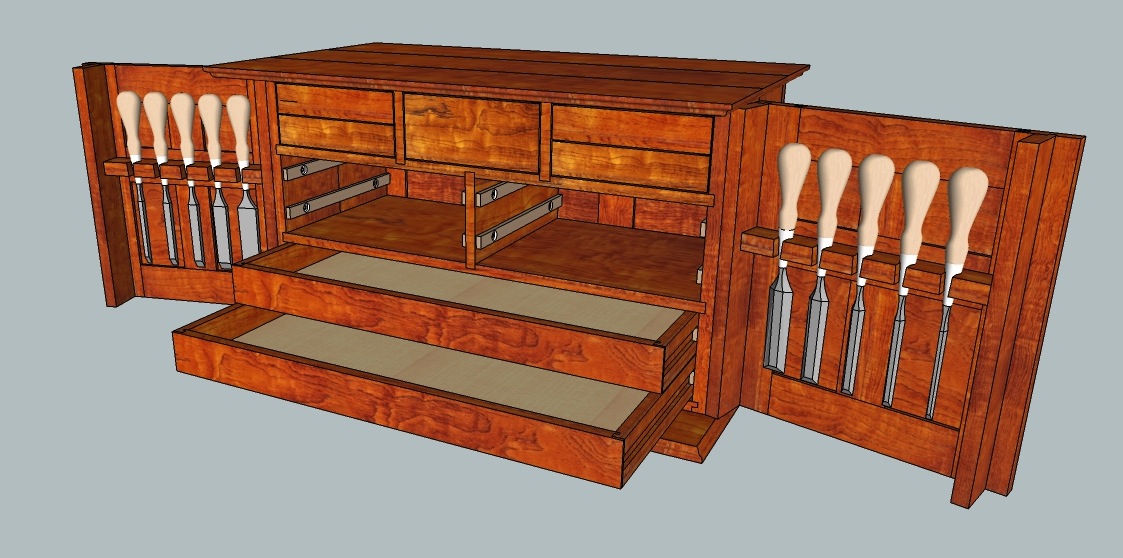Craftsman Tool Chest
-
As I agree with Dave I wouldn't go to the trouble to do the tapered holes in the shop a simple hole and dado as he said earlier but he sorta challenged to see if I could do it in SU so this is how I went about it. Circle tool, made cylinder to 1/16 more than top af taper with PP, scaled bottom of cylinder to ah better to just show you
Sorry about video quality need to improve on that.
-
Good work, Walt.
-
Thanks, that's an extreme compliment coming from my mentor.

-
Well moving forward, sometimes 1 step forward 2 steps back. the chisels were somewhat tedious but it's all about experimenting and trial and error. I hid the middle drawers so the inside was visible.
Thanks for looking

-
Nice work. I think your drawers should have green felt in them So should those in the tool chest.

-
That is looking great Walt. I am impressed.
-
Thanks guy's I think I'm going to model some more tools to put in to it. What's a tool chest without tools right. I'm thinking of a tri square and mallet off the bat. But at a loss for further options. Maybe a few suggestions .
Thanks
-
How about a marking gauge, a striking knife, a little block plane like the LN bronze plane? A dovetail gauge, a sliding bevel gauge, dividers (inside, outside and straight), caliper a couple of pencils and a piece of chalk.
-
Ya why didn't I think of that. Will keep me busy for a while

-
And out of the bars.

-
Well maybe at least before dark
-
Well I've had some time to work on the model. I've really never worked with nested components much before this and it proved to be quite
 but I got it done to my satisfaction for the time being. The problem came when I started to copy the nested components ie the drawers to put on different layers to show the different drawers open and closed like Dave suggested, the components inside the drawer were on the original layer I'm not sure what the proper workflow for that is but I guess it came out right. I made the drawers unique so I could postion the textures so the pieces looked like the where cut the same board as I would do in the shop.The PDF came form LO not very experienced with it yet but will be before this is done. I hope to do one for the tools inside the drawers and on LO for the tool chest with the dimensions to be milled. And one last thing I modeled a Lie Nielsen low angle block plane the problem I had there was how to model the cap iron right I tried several time with Curviloft but struck out.THe pDF can be found if I did it right
but I got it done to my satisfaction for the time being. The problem came when I started to copy the nested components ie the drawers to put on different layers to show the different drawers open and closed like Dave suggested, the components inside the drawer were on the original layer I'm not sure what the proper workflow for that is but I guess it came out right. I made the drawers unique so I could postion the textures so the pieces looked like the where cut the same board as I would do in the shop.The PDF came form LO not very experienced with it yet but will be before this is done. I hope to do one for the tools inside the drawers and on LO for the tool chest with the dimensions to be milled. And one last thing I modeled a Lie Nielsen low angle block plane the problem I had there was how to model the cap iron right I tried several time with Curviloft but struck out.THe pDF can be found if I did it righthttps://dl-web.dropbox.com/get/Public/craftsman%20tool%20chest.pdf?w=ce7eb84a
-
Walt, as to the nested components and layers, you could just make layer associations for the drawers and leave the sub-components (fronts, sides, back, etc.) on Layer 0. Unless you'd have some reason to hide just parts of the drawers, there's no reason to confuse things. The top level component's layer will control the visibility for all of the contents of the nested component.
The plane is a good start. I've got one of those planes and it gets the most use of them all. The finger dimple on the front should be larger. If you want me to I can measure it. As for the cap iron, I would think you could curviloft to do what you need and get pretty close. I would split it in half down its length. Draw the edges and the centerline on top of it. Then draw some curves to create the rounding.
Keep up the good work.
-
Dave your right about the layer association what was I thinking sometimes go down roads I know are wrong.
As for the finger dimple when your in the shop ya check it out, thanks -
I'll get it for you when I get home from work.
-
Thanks
-
Walt, I just measured my little bronze 102. The finger rest on the front is about 0.73 in. dia. and about 0.14 in. high. Front of the plane has a bevel on it andmeasuring from the bottom of the bevel to the finger rest at the middle, it measures about 0.15 in. I hope that helps.
-
Thanks Dave that works for me
-
Advertisement







